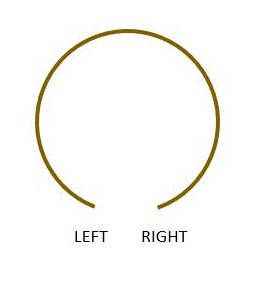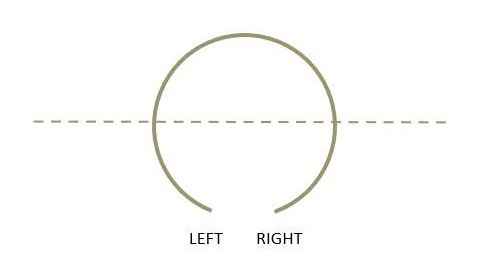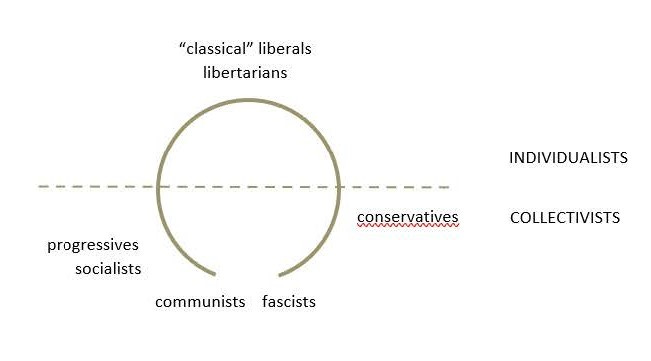What does the political spectrum look like? There are many ways to describe it.
Sometimes people imagine a straight line from left to right. Along this line are the various political philosophies, from communism on the left to fascism on the right.
Of course, there are lots of subcategories and nuances that political theorists would insist upon but let’s not worry about those for now.
I don't like this model, which is inaccurate and misleading. Fortunately there are others. Political theorists have described the political spectrum in various different ways. I like the horseshoe.
My horseshoe looks like this. Imagine that you've got the political spectrum on the straight line, from left to right, but the line is a string. You pick up the middle of string with your fingers and you pull it up so that the ends of the string come down in a circle, almost touching at the bottom. This is the horseshoe idea.
Now we have left and right together near the bottom of the circle or horseshoe. They belong close together because they share a premise: the group is what matters. They believe in governing for group values, group solidarity, group dynanmics. They are willing to supervise people so that they adhere to a common set of ideas.
Now, they don’t agree about what those group values are supposed to be. They have great conflicts about that. But the importance of the group they have in common.
Now draw an imaginary line through the middle of the circle, so as to cut the circle into two:
Above this imaginary line are the individualists. Below the line are collectivists. Above the line, at the top of the circle or horseshoe is where the classical liberals live. It now looks like they're at the center and in a way they are, but they're distinguished from the other two groups because of their fundamental focus on the individual as opposed to the group.
So there are, if you like, not two main political persuasions, left and right, but three: individualists (classical liberals and libertarians), collectivist left (progressives and socialists) and collectivist right (conservatives). The strange thing is that each of these three persuasions or camps believe that there are only two camps.
The conservatives think there are conservatives and liberals. They say sure, there might be a variety of liberals, there might be classical liberals and there might be progressives, but they're all liberals. And liberals are the source of the problem.
The progressives believe that there is only them and the “far right”. The far right is conservatives, the libertarians, the classical liberals, anyone that doesn't believe in critical theory, critical race theory and social justice are right-wing extremists and are wrong.
Finally, through the eyes of classical liberals, the world consists of individualists and collectivists. And progressives and conservatives are both collectivists. They believe in the group over the individual. They believe in the community first. They believe in collectives and institutions. They believe in solidarity, that people should more or less have common values, a common heritage, common tradition, and should be pushing in the same direction.
The conservatives and the progressive both like order. Now, different orders to be sure, but they insist upon order. Classical liberals are fine with chaos, as long as it is peaceful chaos. The priority for classical liberals is peace, no violence. If you're not violent, if you're not using force against each other, whatever you want is fine. It's your life, do what you want. Whereas the progressives and the conservatives are interested in an ordered value system that conforms with their convictions about what is right and wrong.
The only real value that the classical liberals promote is the value of individual choice, individual liberty. The rest of the choices that one might make are the individuals to make. So they're very hands off. The other two groups, the progressives and the conservatives, are hands on. They are much more concerned with content and result as opposed to process. The classical liberals are the process people. Their approach is like how one might describe a classical lawyer’s reasoning. What is the principle, they might ask, and then they would apply the principle to the real world. Rules applied to facts.
An example: the principle of free speech.
If you believe in free speech as a classical liberal, and you encounter people who say things you don't like, well, they're allowed to say those things because that's the principle.
Progressives and conservatives may also endorse the idea of free speech, but it turns out they care less about that process of applying abstract principles to real life. They care more about the content of the result. If someone says something that is morally repugnant, they are likely to say, well yes free speech in principle, but not right now, because it's more important to have the content right than it is to have the process right.
Thanks for reading First Principles with Bruce Pardy! Subscribe for free to receive new posts and support my work.
Bruce Pardy is executive director of Rights Probe and professor of law at Queen’s University.








Came across this video this weekend and shared it with my subscribers! Very well done!
I just watched the interview with Kate Wand. The difficult road of getting people “en masse” rejecting the administrative state might be slightly opened. The less effective it is, the less trust people will have in it. For example, I had a very bad experience recently with employment insurance in Canada: they stopped my insurance benefits after 9 weeks. They took 9 months to render a decision, then I started to receive my benefits, and a little more that 2 months later, the benefits stopped, because it had been one year that my claim was activated, and a claim ceases to be active after one year. I was really upset, but at the same time, I was thinking: “The more they screw up, the more people will want to push them away. And this the ultimate goal right now.”
So great interview. I will translate it in French and overlay voices. I want people in Quebec to access this kind of thinking.